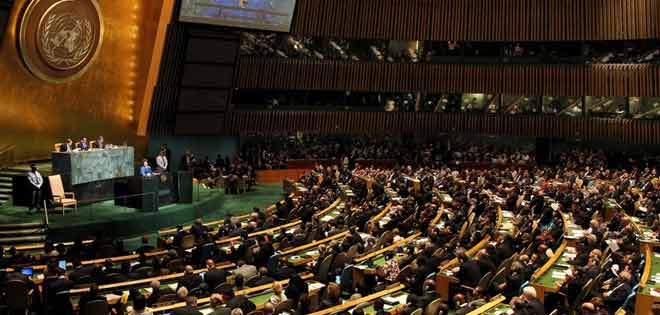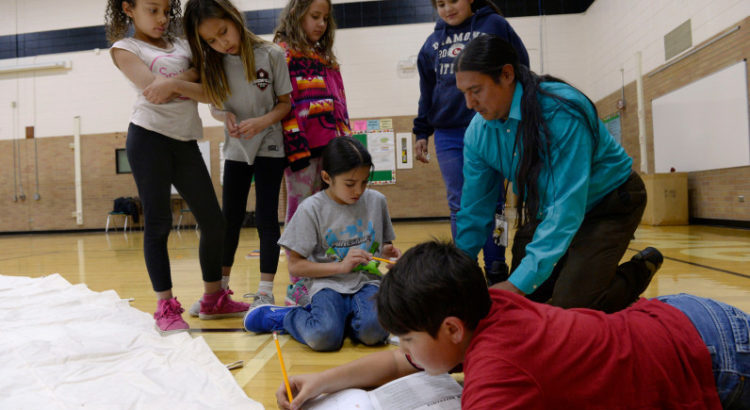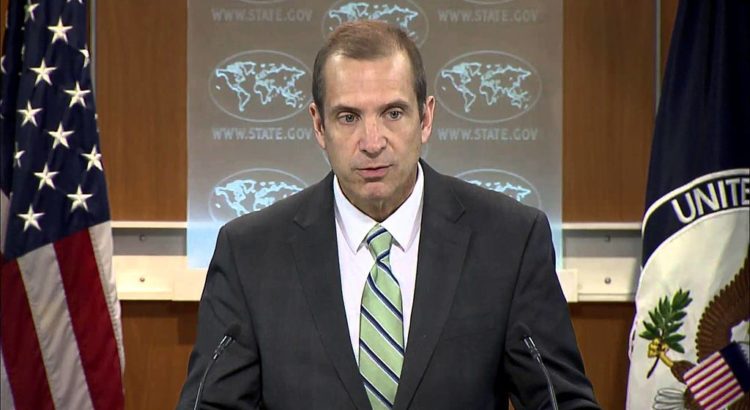Por: Noam Chomsky
Introducción de Tom Engelhardt
No llevaba ni tres meses en el cargo cuando viajó a Praga, capital de la República Checa, para pronunciar unas palabras respecto al dilema nuclear del planeta. Fueron unas palabras que podían haber procedido de un activista antinuclear o de alguien perteneciente al movimiento, entonces en ciernes, contra el cambio climático, no del presidente de los Estados Unidos. A la vez que pedía el uso de nuevas formas de energía, Barack Obama habló con rara elocuencia presidencial sobre los peligros de un mundo en el que las armas nucleares se propagaban y de cómo ese hecho, si no se controlaba, haría “inevitable” su utilización. Pidió “un mundo sin armas nucleares” y dijo sin rodeos: “Cómo única potencia nuclear que ha utilizado un arma nuclear, EEUU tiene la responsabilidad moral de actuar”. Incluso se comprometió a adoptar “medidas concretas” para empezar a construir un mundo sin esa clase de armas.
Siete años después, aquí está el récord del primer y posiblemente único presidente abolicionista estadounidense. El arsenal nuclear de EEUU -4.571 ojivas (muy por debajo de las casi 19.000 existentes en 1991, cuando se derrumbó la Unión Soviética)- sigue siendo lo suficientemente grande como para destruir varios planetas del tamaño de la Tierra. Según la Federación de Científicos de EEUU, las últimas cifras del Pentágono sobre tal arsenal indican que “el gobierno de Obama ha reducido el arsenal estadounidense mucho menos que cualquier otro posterior a la Guerra Fría, y que el número de ojivas nucleares desmanteladas en 2015 fue el más bajo desde que el presidente Obama asumió el cargo”. Es decir, poniendo estos datos en perspectiva, que Obama ha hecho mucho menos que George W. Bush en lo referente a la reducción del arsenal estadounidense existente.
Al mismo tiempo, nuestro abolicionista presidente está ahora liderando la llamada modernización de ese mismo arsenal, un proyecto inmenso de tres décadas de duración cuyo coste estimado será al menos de un billón de dólares, cifra por supuesto anterior al exceso habitual de gastos que se producirá. Durante el proceso se producirán nuevos sistemas de armas, se crearán los primeros misiles nucleares “inteligentes” (piensen en esto: armas de “precisión” con “resultados” mucho más reducidos, lo que implica empezar a utilizar armas nucleares en el campo de batalla) y Dios sabe qué más.
Ha logrado un éxito en el terreno antinuclear, su acuerdo con Irán para asegurar que este país no produzca tal arma. Sin embargo, un dato tan desalentador en un presidente al parecer decidido a situar a EEUU en la senda abolicionista nos dice algo sobre el dilema nuclear y el peso que el Estado de seguridad nacional tiene en su pensamiento (y, presuntamente, en el de cualquier futuro presidente).
No es poco horror que en este planeta nuestro la humanidad continúe impulsando dos fuerzas apocalípticas, cada una de las cuales –una en un relativo instante y la otra a lo largo de muchas décadas- podría paralizar o destruir la vida humana tal y como la conocemos. Ese debería ser un hecho aleccionador para todos nosotros. Es el tema sobre el que Noam Chomsky reflexiona en este ensayo de su nuevo y destacado libro Who Rules the World?
***
En enero de 2015, el Boletín de Científicos Atómicos adelantó su famoso Doomsday Clock (Reloj del Apocalipsis) a tres minutos para la medianoche, un nivel de amenaza que no se había alcanzado a lo largo de treinta años. El comunicado del Boletín explicaba que tal avance hacia la catástrofe invocaba las dos amenazas más importantes para la supervivencia: las armas nucleares y el “cambio climático descontrolado”. El llamamiento condenaba a los dirigentes mundiales por “no actuar con la velocidad y escala requeridas para proteger a los ciudadanos de la potencial catástrofe”, poniendo en peligro a cada persona sobre la Tierra al fracasar en la que era su tarea más importante: asegurar y preservar la salud y vitalidad de la civilización humana”.
Desde entonces, hay muy buenas razones para pensar en mover las manillas del reloj incluso más cerca del día del apocalipsis.
Cuando 2015 llegaba a su fin, los líderes mundiales se reunieron en París para lidiar con el grave problema del “cambio climático incontrolado”. Apenas pasa un día sin una nueva prueba de lo grave que es la crisis. Por citar algo casi al azar, poco antes de la apertura de la conferencia de París, el Laboratorio de Propulsión a Chorro de la NASA publicó un estudio que sorprendió, a la vez que alarmó, a los científicos que han estado estudiando el hielo del Ártico. El estudio mostraba que un inmenso glaciar de Groenlandia, el Zacharie Isstrom, “se había desprendido en 2012 de una posición glacialmente estable y había entrado en una fase de repliegue acelerado”, un hecho inesperado e infausto. El glaciar “contiene agua suficiente como para elevar el nivel global del mar en más de 46 centímetros si llegara a derretirse completamente. Y ahora está metido ya de lleno en una dieta extrema, perdiendo 5.000 millones de toneladas de masa cada año. Todo ese hielo está derrumbándose sobre la zona norte del Océano Atlántico”.
No obstante, había pocas esperanzas de que los dirigentes mundiales en París “actuasen con la velocidad y a la escala requeridas para proteger a los ciudadanos de una potencial catástrofe”. E incluso si por algún milagro hubieran actuado así, habría tenido un valor limitado por razones que deberían ser profundamente preocupantes.
Cuando se aprobó el acuerdo de París, el ministro francés de Asuntos Exteriores, Laurent Fabius, que albergó las negociaciones, anunció que era “legalmente vinculante”. Ojalá que así fuera, pero hay más de unos cuantos obstáculos que merecen una atención cuidadosa.
En toda la amplia cobertura de los medios de comunicación de la conferencia de París, quizá las frases más importantes fueran estas, enterradas cerca del final de un largo análisis ofrecido por el New York Times: “Tradicionalmente, los negociadores han tratado de forjar un tratado legalmente vinculante que necesitara de la ratificación de los gobiernos de los países participantes para tener fuerza. No hay forma de conseguir eso en este caso por culpa de Estados Unidos. Un tratado estaría muerto si llega al Capitolio sin la necesaria votación mayoritaria de dos tercios de un Senado bajo control republicano. Por tanto, los planes facultativos están tomando el lugar de los objetivos obligatorios de arriba a bajo”. Y los planes facultativos son una garantía de fracaso.
“Por culpa de Estados Unidos”. Más concretamente, por culpa del Partido Republicano, que se está convirtiendo ya en un peligro real para la supervivencia humana decente.
Las conclusiones aparecen subrayadas en otro artículo del Times sobre el acuerdo de París. Al final de una larga historia encomiando el logro, el artículo señala que el sistema creado en la conferencia “depende en muy gran medida de los puntos de vista de los futuros dirigentes mundiales que desarrollen esas políticas. En EEUU, todos los candidatos republicanos que se presentaban a presidente en 2016 han cuestionado o negado el carácter científico del cambio climático y han expresado su oposición a las políticas sobre el cambio climático de Obama. En el Senado, Mitch McConnell, el líder republicano que ha estado al frente de la campaña contra la agenda del cambio climático de Obama, dijo: ‘Antes de que sus socios internacionales descorchen el champán, deberían recordar que este es un acuerdo inalcanzable basado en un plan energético interno que probablemente es ilegal, que la mitad de los Estados están tratando de parar y que el Congreso ha votado ya en su contra.’”
Ambos partidos han estado girando hacia la derecha durante el período neoliberal de la última generación. La principal corriente demócrata se parece mucho ahora a los que solíamos tildar de “republicanos moderados”. Mientras tanto, el Partido Republicano se ha desplazado en gran medida fuera del espectro, convirtiéndose en lo que el respetado analista político conservador Thomas Mann y Normal Ornstein llaman “una insurgencia radical” que prácticamente ha abandonado la política parlamentaria normal. Con la deriva hacia la extrema derecha, el compromiso del Partido Republicano con la riqueza y los privilegios se ha hecho tan extremado que sus políticas reales podrían no atraer votantes, por tanto, han tenido que buscar una nueva base popular movilizada en otros campos: los cristianos evangélicos que esperan la Segunda Venida, los patriotas fanáticos que temen que “ellos” están quitándonos nuestro país, los racistas recalcitrantes, la gente con quejas reales que confunde gravemente las causas de las mismas y otros como ellos que son presas fáciles de los demagogos y que pueden convertirse fácilmente en una insurgencia radical.
En los últimos años, el establishment republicano ha conseguido suprimir las voces de la base que se había movilizado. Pero eso se acabó. A finales de 2015, el establishment estaba manifestando considerable desaliento y desesperación por su incapacidad para lograrlo, ya que la base republicana y sus opciones estaban fuera de todo control.
Los contendientes republicanos electos para la próxima elección presidencial manifestaron un claro desprecio por las deliberaciones de París, negándose incluso a asistir a los actos. Los tres candidatos que lideraban las encuestas en aquel momento –Donald Trump, Ted Cruz y Ben Carson- adoptaron la posición de la base mayoritariamente evangélica: los seres humanos no tienen impacto en el calentamento global, si es que tal cosa está verdaderamente produciéndose.
Los otros candidatos se niegan a que el gobierno actúe en esa esfera. Inmediatamente después de que Obama hablara en París prometiendo que EEUU estaría a la vanguardia de la búsqueda de la actuación global, el Congreso, bajo dominio republicano, votó a favor de tumbar sus recientes normas en la Agencia de Protección Medioambiental para reducir las emisiones de carbono. Como informó la prensa, este fue “un mensaje provocador ante más de 100 líderes mundiales, en el sentido de que el presidente estadounidense no cuenta con el apoyo total de su gobierno en la política sobre el clima”, por decirlo de forma eufemista. Mientras tanto, Lamar Smith, presidente republicano del Comité para la Ciencia, el Espacio y la Tecnología del Congreso, siguió adelante con su yihad contra los científicos del gobierno que se atreven a informar sobre los hechos.
El mensaje está claro. Los ciudadanos estadounidenses se enfrentan a una responsabilidad enorme en casa.
Una historia parecida informaba en el New York Times de que “las dos terceras partes de los estadounidenses apoyan que EEUU se incorpore a un acuerdo internacional vinculante para frenar el crecimiento de las emisiones de gases invernadero”. Y, por un margen de cinco a tres, los estadounidenses consideran que el clima es más importante que la economía. Pero no importa. Pasan por encima de la opinión pública. Ese hecho, una vez más, está enviando un mensaje fuerte a los estadounidenses. Es responsabilidad suya sanar un sistema político disfuncional en el que la opinión pública es un factor marginal. La disparidad entre opinión pública y política, en este caso, tiene implicaciones muy importantes para el destino del planeta.
Desde luego que no deberíamos hacernos ilusiones sobre una “edad dorada” del pasado. Sin embargo, los hechos que acabamos de revisar constituyen cambios significativos. El debilitamiento de la democracia funcional es una de las contribuciones del ataque neoliberal contra la población mundial en la última generación. Y esto no está sucediendo sólo en EEUU; el impacto puede ser mucho peor en Europa.
El cisne negro que nunca podemos ver
Pasemos a otra de las preocupaciones (tradicionales) de los científicos atómicos que ajustan el reloj del día del juicio final: las armas nucleares. La amenaza actual de guerra nuclear justifica ampliamente su decisión de enero de 2015 de adelantar el reloj dos minutos para la medianoche. Lo acaecido desde entonces revela más claramente aún la creciente amenaza, un asunto que, en mi opinión, suscita una preocupación insuficiente.
La última vez que el reloj del juicio final se avanzó tres minutos para la medianoche fue en 1983, en la época de los ejercicios Able Archer de la administración Reagan; estos ejercicios simularon ataques contra la Unión Soviética para poner a prueba sus sistemas de defensa. Los archivos rusos publicados recientemente revelan que los rusos estaban profundamente preocupados por las operaciones y se preparaban para responder, lo que habría sencillamente significado: FIN.
Hemos sabido más cosas acerca de esos ejercicios precipitados e imprudentes y de cómo el mundo se abocaba al desastre por el analista militar y de inteligencia de EEUU Melvin Goodman, que fue jefe de división de la CIA y alto analista de la Oficina de Asuntos Soviéticos en aquella época. “Además de los ejercicios y movilizaciones del Able Archer que alarmaron al Kremlin”, escribe Goodman, “la administración Reagan autorizó ejercicios militares inusualmente agresivos cerca de la frontera soviética que, en algunos casos, violaron la soberanía territorial soviética. Las arriesgadas medidas del Pentágono incluyeron el envío de bombarderos estratégicos estadounidenses sobre el Polo Norte para poner a prueba el radar soviético y ejercicios navales bélicos próximos a la URSS por zonas donde los buques de guerra estadounidenses no habían entrado anteriormente. Además, una serie de operaciones secretas simularon ataques navales sorpresa sobre objetivos soviéticos”.
Ahora sabemos que el mundo se salvó de una probable destrucción nuclear en aquellos aterradores días gracias a la decisión de un oficial ruso, Stanislav Petrov, que no trasmitió a sus autoridades superiores el informe de los sistemas de detección automática de que la URSS estaba bajo un ataque de misiles. Por consiguiente, Petrov ocupó un lugar junto al comandante de submarinos rusos Vasili Arkhipov, quien, en un momento peligroso de la crisis de los misiles cubana de 1962, se negó a autorizar el lanzamiento de torpedos nucleares cuando los submarinos estaban bajo ataque de los destructores estadounidenses imponiendo una cuarentena.
Otros ejemplos recientemente revelados enriquecen un récord realmente aterrador. El experto en seguridad nuclear Bruce Blair informa que “cuando el presidente de EEUU estuvo más cerca de lanzar una decisión estratégica inadecuada fue en 1979, cuando una grabación de entrenamiento de alerta temprana NORAD describiendo un ataque estratégico soviético a escala total se cursó inadvertidamente a través de la red de alerta temprana real. Al asesor nacional de seguridad Zbigniew Brzezinski le llamaron dos veces en medio de la noche y le dijeron que EEUU estaba bajo ataque, que sólo tenía que descolgar el teléfono y persuadir al presidente Carter de que era necesario que autorizara de inmediato una respuesta a escala total, cuando se produjo una tercera llamada para decirle que se había tratado de una falsa alarma”.
Este ejemplo recién revelado trae a mi mente un incidente crítico de 1995, cuando la trayectoria de un cohete noruego-estadounidense con equipamiento científico parecía la trayectoria de un misil nuclear. Esto suscitó las preocupaciones rusas, que rápidamente se hicieron llegar al presidente Boris Yeltsin, encargado de decidir si había que lanzar un ataque nuclear.
Blair añade otros ejemplos de su propia experiencia. Hubo un caso, en la época de la guerra en Oriente Medio de 1967, “en que se envió una orden de ataque real a la tripulación de un portaaviones nuclear en vez una orden de ejercicios/entrenamiento nuclear”. Pocos años después, a principos de la década de 1970, el Mando Aéreo Estratégico en Omaha “retransmitió una orden de ejercicio de lanzamiento como si fuera una orden de lanzamiento real en un mundo real”. En ambos casos habían fallado los controles de los códigos y la intervención humana impidió el lanzamiento. “¿Se dan cuenta?”, añade Blair. “No era nada raro que se produjeran ese tipo de chapuzas”.
Blair hizo estos comentarios en reacción a un informe del aviador Johan Bordne que sólo hace muy poco ha publicado la Fuerza Aérea de EEUU. Bordne estaba sirviendo en la base militar estadounidense en Okinawa en octubre de 1962, en la época de la crisis de los misiles cubanos y también en un momento de graves tensiones en Asia. Se había elevado el sistema de alerta nuclear estadounidense a DEFCON 2, un nivel por debajo de DEFCON 1, cuando los misiles nucleares pueden ser inmediatamente lanzados. En el pico de la crisis, el 28 de octubre, una tripulación de misiles recibió autorización, por error, para lanzar sus misiles nucleares. Decidieron que no, evitando una probable guerra nuclear y uniéndose a Petrov y Arkhipov en el panteón de los hombres que decidieron desobedecer el protocolo, salvando así al mundo.
Como Blair observó, ese tipo de incidentes no eran infrecuentes. Un estudio reciente de un experto detallaba docenas de falsas alarmas durante todos los años del período revisado de 1977 a 1983; el estudio concluía que el número de las mismas fluctuó entre 43 y 255 por año. El autor del estudio, Seth Baum, resume con estas adecuadas palabras: “La guerra nuclear es el cisne negro que nunca podemos ver, excepto en el breve momento en que nos está matando. Aplazamos la eliminación del peligro por nuestra propia cuenta y riesgo. Es hora ya de abordar la amenaza, porque ahora estamos todavía vivos”.
Estos informes, al igual que los que contiene el libro de Eric Scholosser “Command and Control”, se ajustan en gran medida a los sistemas de EEUU. Los rusos son sin duda mucho más propensos a los errores. Por no mencinar el peligro extremo que plantean los sistemas de otros, especialmente Pakistán.
“Una guerra ya no es algo impensable”
En ocasiones la amenaza no ha sido consecuencia de un accidente, sino del aventurerismo, como en el caso del Able Archer. El caso más extremo fue la crisis de los misiles cubanos en 1962, cuando la amenaza de desastre fue demasiado real. La forma de abordar dicha crisis fue impactante; al igual que el modo habitual de interpretarla.
Con este sombrío antecedente en mente, es útil mirar los debates y planes estratégicos. Un caso escalofriante fue el estudio “Essentials of Post-Cold War Deterrence” del STRATCOM de 1995, en la era Clinton. El estudio pretende conservar el derecho al primer ataque, incluso contra Estados no nucleares. Explica que las armas nucleares se utilizan constantemente en el sentido de que “proyectan una sombra sobre cualquier crisis o conflicto”. Insta también a disponer de un “personaje nacional” irracional y ansioso de venganza para intimidar al mundo.
La doctrina actual se explora en el artículo principal de la revista International Security, una de las más acreditadas en el campo de las doctrinas estratégicas. Los autores explican que EEUU está comprometido con la “primacía estratégica”, es decir, aislamiento de un ataque de represalia. Esta es la lógica de la “nueva triada” de Obama (reforzar la potencia de submarinos, misiles terrestres y bombarderos), junto con la defensa con antimisiles para contrarrestar un ataque de represalia. La preocupación que plantean los autores es que la exigencia estadounidense de primacía estratégica podría inducir a China a abandonar su política “de no ser el primero en utilizar armas nucleares” y ampliar su disuasión limitada. Los autores piensan que no lo hará, pero la perspectiva sigue siendo incierta. La doctrina acentúa claramente los peligros en una región tensa y conflictiva.
Lo mismo sucede con la expansión de la OTAN hacia el este violando las promesas verbales hechas a Mijail Gorbachev cuando la URSS estaba derrumbándose y accedió a permitir que una Alemania unificada formara parte de la OTAN, una concesión muy notable si uno piensa en la historia del siglo. La expansión hacia la Alemania del Este se produjo de inmediato. En los años siguientes, la OTAN se expandió por las fronteras rusas; ahora hay sustanciales amenazas incluso para incorporar a Ucrania, en el corazón geoestratégico de Rusia. Uno puede imaginar cómo reaccionaría EEUU si el Pacto de Varsovia estuviera aún con vida, hubiera incorporado a él a América Latina y ahora México y Canadá estuvieran solicitando su entrada.
Aparte de eso, Rusia entiende, al igual que China (y los estrategas estadounidenses, si vamos al caso), que los sistemas de defensa de misiles de EEUU cerca de las fronteras rusas son, en efecto, un arma de primer ataque con el objetivo de establecer una primacía estratégica: inmunidad ante la represalia. Quizá su misión sea totalmente inviable, como algunos especialistas apuntan. Pero los objetivos no van a confiar nunca en eso. Y las reacciones militantes de Rusia son muy naturalmente interpretadas por la OTAN como una amenaza para Occidente.
Un destacado experto británico en Ucrania plantea lo que denomina “paradoja geográfica fatídica”: que la OTAN “existe para manejar los riesgos creados por su propia existencia”.
Las amenazas son muy reales ahora. Por fortuna, el derribo de un avión ruso por un F-16 turco en noviembre de 2015 no produjo un incidente internacional, pero podía haberlo hecho, especialmente teniendo en cuenta las circunstancias. El avión iba a una misión de bombardeo en Siria. Pasó durante tan sólo 17 segundos a través de una franja de territorio turco que sobresale hacia Siria, y era evidente que se dirigía a este país cuando se estrelló. Derribarlo parece haber sido un acto innecesariamente imprudente y provocador, un acto con consecuencias.
La reacción de Rusia fue anunciar que sus bombarderos irían a partir de ahora acompañados por aviones de combate y que iba a desplegar en Siria un sofisticado sistema de misiles antiaéreos. Rusia ordenó también a su portaaviones Moskva, dotado de un sistema de defensa aérea de largo alcance, que se acercara más a la costa, para que estuviera “preparado para destruir cualquier objetivo aéreo que supusiera una amenaza potencial para nuestros aviones”, anunción el ministro de Defensa Sergei Shoigu. Todo esto prepara el escenario para confrontaciones que podrían ser letales.
Las tensiones son asimismo constantes en las fronteras entre Rusia y la OTAN, incluyendo maniobras militares de ambas partes. Poco después de que el reloj del juicio final se moviera amenazadoramente más cerca de la medianoche, la prensa nacional informaba que los “vehículos militares de combate de EEUU desfilaban el miércoles por una ciudad de Estonia que se adentra en Rusia, un acto simbólico que ponía de relieve las apuestas por ambas partes en medio de las peores tensiones entre Occidente y Rusia desde la Guerra Fría”. Poco antes, un avión de combate ruso estuvo a unos segundos de chocar con un avión civil danés. Ambas partes están llevando a cabo rápidas movilizaciones y redespliegues de fuerzas en la frontera entre Rusia y las fuerzas de la OTAN, y “ambas creen que una guerra no es ya algo impensable”.
Perspectivas de supervivencia
Si eso es así, ambas partes están más allá de la locura, porque una guerra bien podría destruirlo todo. Durante décadas se ha reconocido que un primer ataque por parte de una potencia importante podría destruir al atacante, incluso aunque no hubiera represalias, sencillamente por los efectos del invierno nuclear.
Pero así es el mundo actual. Y no sólo el de hoy en día, eso es lo que estamos viviendo desde hace setenta años. El razonamiento es de punta a cabo sorprendente. Como hemos visto, la seguridad de la población no es básicamente una preocupación importante para los políticos. Eso ha sido así desde los primeros días de la era nuclear, cuando en los centros de formación política no se hacía esfuerzo alguno –al parecer, ni siquiera se expresaba el pensamiento- para eliminar una potencial amenaza grave para EEUU, como podría haber sido posible. Y así continúan las cosas hasta ahora, en formas sólo brevemente paladeadas.
Ese es el mundo en el que hemos estado viviendo y en el que vivimos en estos momentos. Las armas nucleares representan un constante peligro de destrucción inmediata pero, al menos en principio, sabemos cómo aliviar la amenaza, incluso cómo eliminarla, una obligación emprendida (y despreciada) por las potencias nucleares que han firmado el Tratado de No Proliferación. La amenaza de calentamiento global no es instantánea, a pesar de su gravedad a largo plazo que podría incrementarse repentinamente. Que tengamos capacidad para lidiar con ello no está del todo claro, pero no puede haber duda de que cuanto más nos demoremos, más terrible será el desastre.
Las perspectivas para la supervivencia decente a largo plazo no son muy grandes a menos que se produzca un cambio significativo de rumbo. Una gran parte de la responsabilidad está en nuestras manos, las oportunidades también.
Fuente: https://www.rebelion.org/noticia.php?id=213609
Imagen: https://actualidad.rt.com/actualidad/165077-armas-nucleares-rusia-miedo-occidente














 Users Today : 9
Users Today : 9 Total Users : 35461624
Total Users : 35461624 Views Today : 16
Views Today : 16 Total views : 3422247
Total views : 3422247